9 Best Spot Lock Trolling Motors (2023 Buyer’s Guide)
UPDATED 03 NOVEMBER 2023
This article may contain affiliate links. If you make a purchase after clicking on a link we may earn a small commission at no extra cost to you.
Spot lock has revolutionized the world of recreational fishing ever since bass pro Ott Defoe won the Bass Elite Series Tournament 2016 in La Crosse with a Minn Kota Ultrex.
But if you’re thinking about getting a trolling motor with spot lock, it’s essential to know what to look for in the top performing trolling motors currently available, and how to choose the right one.
My team and I tested the best trolling motors with spot lock on the market, and evaluated them based on their thrust, voltage, sonar compatibility and overall performance.
From our testing, here are our picks for the best spot lock trolling motors in 2023:
- Best overall: Lowrance Ghost
- Best budget option: Minn Kota PowerDrive
- Best runner up: Garmin Force
- Best value for money: Minn Kota Ultrex
- Best freshwater option: MotorGuide Xi5
- Best saltwater option: Minn Kota Riptide Terrova
- Best runner up budget option: Haswing Cayman
- Best option for kayak: MotorGuide Xi3 (36″)

What is the best spot lock trolling motor in 2023?
The table above compares the most important specs and features of the best spot lock trolling motors in 2023.
My team and I tested 7 of these trolling motors on our own boats, and for the remaining 2 we surveyed other boat owners to get their most important insights for you.
Now let’s dive into the details, and take a closer look at each of these trolling motors.
Lowrance Ghost
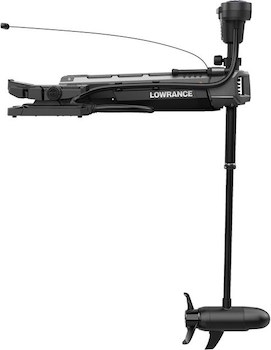

Our verdict: The Lowrance Ghost is the best spot-lock trolling motor overall
When the Lowrance Ghost came out in 2019, it challenged the market dominating position of the Minn Kota Ultrex, which had been the industry gold standard until then.
So what’s so good about the Ghost? In short, it can do everything the Ultrex can, but in addition brings a whole set of new capabilities to the table.
First of all, the Ghost comes with a brushless motor, making it a lot quieter (which explains its name), as well as stronger and more efficient. In case you’ve ever tried a brushless drill, you’ll understand what I mean.
With a brushless motor, most of the power is transferred directly to turning the prop, since there is less internal resistance.
This makes the Ghost more efficient in open water, and when we put it to the test, it also had extra power when driving through weeds.
The Ghost can be used either with a 24V or 36V battery system, making it more versatile in terms of power supply than other trolling motors.
This means that you can adjust the thrust of the Ghost simply by changing the voltage of the battery (24V generates 97 lb thrust, and 36V generates 120 lb thrust).
With 120 lb thrust, the Ghost also has the highest thrust rating of all motors we tested, making it more reliable than all other trolling motors, and is capable of holding spot lock position accurately with a fully loaded boat, even in strong wind or current.
Another great feature of the Ghost is that it gives you the ability to program two custom buttons on its foot pedal, which you can use for anything you want (for example, for creating waypoints, or for controlling your shallow water anchors).
Also the button for engaging the prop can be quickly moved from side to side, making it easier to switch over from a Minnkota or PowerGuide pedal.
And finally, the Ghost comes with a standard Lowrance HDI transducer, which can be replaced with a more powerful 3-in-1 active imaging transducer.
The latter comes with CHIRP in the regular 2D sonar, but not in the down scan and side scan imaging sonar. Also, unlike the Garmin Force, it doesn’t have a 1200 kilohertz UHD frequency.


Features:
- Brushless motor design
- Cable management system
- 360 degree breakaway mount
- Gas shock lift assist feature on the mount
- Dual 24V/36V voltage compatibility
Minn Kota PowerDrive


Our verdict: The Minn Kota PowerDrive is the best spot lock trolling motor on a budget
Minn Kota have been industry leaders ever since they invented the first electric trolling motor in 1934.
And while the PowerDrive is one of the most affordable models on the market, it still comes with the characteristic high end quality of a Minn Kota trolling motor.
You can choose between 55 lb or 70 lb thrust, which should be strong enough for small bass boats (though I highly recommend calculating how much thrust you need based on the fully loaded weight of your boat).
Out of the various models that we tested, the PowerDrive is a bare bones option that comes without any additional frills (such as a transducer, foot pedal, heading sensor, or jog). But the great thing about this is that it gives you access to basic GPS anchor functionality at a very affordable price.
And while the PowerDrive doesn’t have a foot pedal, it does come with an i-Pilot remote, allowing you to control your trolling motor from anywhere on the boat, and it also provides basic autopilot functionality.
Depending on your preference, you can also control the i-Pilot from your smartphone with a mobile app (available for both iOS and Android). And just like all Minn Kota models, the composite shaft comes with a lifetime warranty.


Features
- i-Pilot GPS
- Weedless prop
- Deploy-assist lever
Garmin Force
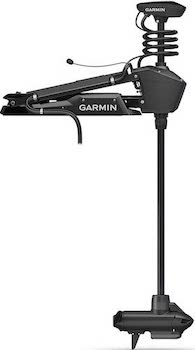

Our verdict: The Garmin Force is the runner up best spot lock trolling motor
The Force was released in 2019, and is Garmin’s first trolling motor. Just like the Lowrance Ghost, one of its main distinguishing features is its brushless motor, which makes it quieter, stronger, and more energy efficient than regular trolling motors.
The brushless motor technology sets both the Force and the Ghost well apart from their competitors.
Also, just like the Ghost, the Force can be used with either a 24V or a 36V battery. If you use it with a 24V battery, this generates 80 lb thrust, while using it with a 36V battery generates 100 lb thrust.
The foot pedal of the Garmin Force is wireless, and can be used to control its GPS anchor functionality with a quick tap of the foot.
It runs on two AA batteries, though you can also opt to use the power cable that comes in the box to hook it up to your boat’s battery. The latter option is the better choice if you fish a lot.
Based on our testing, one of the strengths of the Force is that it comes with a high quality built-in transducer, giving you access to high end Garmin sonar imaging – including high wide CHIRP, ClearVu (Garmin’s version of down imaging), and SideVu (side imaging).
The transducer not only includes 455/800 kilohertz frequencies, but also the 1200 UHD frequency, which makes its sonar capabilities significantly more powerful than any of its competitors.
However, keep in mind that if you want to make full use of the transducer (including UHD imaging), you need to connect it with one of two compatible Garmin units: either the Echomap Ultra, or GPSMAP 8600, which both support direct connect UHD sonar.
Finally, another great thing about the Force is that it can network via Bluetooth with other Garmin electronics, which makes it a lot easier to work with, since there is no need for NMEA 2000 networks or ethernet cables.


Features
- Brushless motor design
- Scissor mount with cable management system
- Indicator panel on mount with prop status, battery status, and GPS status
- Dual 24V/36V voltage compatibility
Minn Kota Ultrex


Our verdict: The Minn Kota Ultrex is the best spot-lock trolling motor considering value for money
When it first came out in 2017, the Ultrex immediately set the industry standard as the best of its kind at the time, and has remained a favorite among bass anglers since then.
A lot of this popularity is due to the fact that this spot lock trolling motor comes with the new and improved Minn Kota i-Pilot system, which has highly accurate anchor lock functionality.
In addition to its accuracy, the Ultrex also comes with jog functionality, which sets it apart from many other brands. This functionality enables you to move your boat 5 feet in any direction from an existing GPS position, which is extremely useful for systematically dissecting any fish-holding location (such as a drop off, point, brush pile, etc.).
With either 80 or 100 lb thrust, the Ultrex is significantly stronger than the PowerDrive, which makes it more suitable for mid to large sized bass boats. But again, make sure to calculate the right amount of thrust that you need by referring to the table at the bottom of this article.
From our testing, another great thing about the Ultrex is that it feels like a cable steer motor (and in fact comes with a foot pedal with wire cable).
This effect is achieved with a power steering functionality that combines the best of cable steer and electric steer motors. You can use heel/toe steering to steer the motor with your foot, without having to stop fishing.
If you get the Ultrex with a built-in universal transducer, this can be used with any fish finder brand. But on the downside, this only has a 83/200 kilohertz transducer, which is relatively limited in terms of its sonar capabilities.
However, if you get the Ultrex with a MEGA DI or SI transducer, this gives you access to much higher quality sonar imaging, but these transducers only work with Humminbird fish finders.
Also, if you want to network the Ultrex with your Humminbird electronics, you need to get it with i-Pilot link, since the regular i-Pilot doesn’t support that.
In summary, while the Ultrex isn’t quite as advanced as the Lowrance Ghost and the Garmin Force in terms of its motor technology, it still provides everything that most anglers need, and comes at a significantly lower cost than its high end competitors. Bottom line: for us, the Ultrex is the best value for money.


Features
- Cable steer/electric steer hybrid
- Heading sensor
- Spot lock jog
- Built-in transducer
MotorGuide Xi5
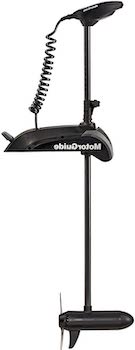

Our verdict: The MotorGuide Xi5 is the best spot lock trolling motor for freshwater
The Xi5 wireless GPS model is an excellent choice for any freshwater anglers who want to get access to advanced GPS functionalities, but without paying the high end price needed to get an Ultrex, Ghost, or Force.
With its Pinpoint GPS system, the MotorGuide provides the same level of accuracy as Minn Kota’s trolling motors, but at a lower cost.
In addition to this, it also provides ‘jog’ functionality, which allows you to move your boat a few feet in any direction from a GPS position, which is great for systematically covering a fishing location.
It comes with a wireless electric steer foot pedal plus remote control, enabling you to control your motor from anywhere on the boat. It’s 3 blade prop is more weedless than regular 2 blade props, which means you probably won’t need a separate weedless prop.
The composite shaft of this spot lock trolling motor is highly durable, and comes with a lifetime warranty (which is also similar to Minnkota models).
During our testing, we found that one of the biggest advantages of the Xi5 is that its built-in transducer is compatible with Lowrance, Humminbird and Garmin fish finder units (though it only provides basic 2D sonar).


Features
- 3 blade prop
- Built-in transducer compatible with all sonar brands
Minn Kota Riptide Terrova
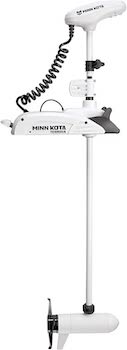

Our verdict: The Minn Kota Riptide Terrova is the best spot-lock trolling motor for saltwater
If you’re looking for a good saltwater trolling motor, then the Riptide Terrova is an excellent choice.
This spot lock trolling motor comes with up to 112 lb thrust, and a maximum shaft length of 87 inches, which is exactly what you need to keep an ocean going vessel steady in the current or wind. And by the way, the extra long shaft length makes this a good option for use on a pontoon.
Personally, I’ve been using a 112lb thrust Riptide Terrova for years on my 30 foot Ocean Master, and it can accurately hold the position even in a 25 mph wind. This enables me to position my boat effortlessly over a wreck or reef, and also comes in handy when fishing close to rocks.
And just like the Ultrex, the Riptide Terrova comes with i-Pilot and a Heading Sensor, which is necessary for jog functionality, enabling you to move 5 feet in any direction from a GPS position. This is great when you are following a school of fish, and notice them moving in a specific direction with your fish finder.
If you get the Riptide Terrova with i-Pilot Link, that also enables you to network your i-Pilot with other Humminbird devices on your boat, which is nice if you want to use your mapping device to direct the autopilot of the trolling motor.
You can also program the i-Pilot to take you to previously saved waypoints, or to retrace a saved track.


Features
- i-Pilot Link networks with Humminbird devices
- Digital Maximizer
- Weedless prop
- Mobile app compatible
- Composite shaft with lifetime warranty
Haswing Cayman GPS
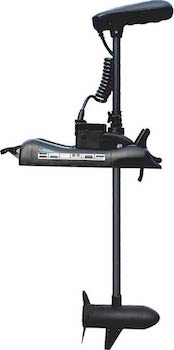

Our verdict: The Haswing Cayman GPS is the runner up best gps lock trolling motor on a budget
Next to the Minn Kota PowerDrive, the Haswing Cayman GPS is the most affordable spot lock trolling motor on this list. However, unless you get the short 48” shaft, it’ll cost you about 100 to 200 dollars more than the PowerDrive.
Also, unlike the Minn Kota, which is made in the USA, the Haswing Cayman is built in China. While this doesn’t necessarily mean it’s lower quality, I thought you should know that before you buy.
One advantage that the Cayman has over the PowerDrive is that it comes with a wireless foot pedal, as well as a remote control. In addition to that you can also download an app called the Helmsman App, which you can use to save GPS waypoints, and saved routes.
In other words, you can set the autopilot to take you along a saved route with the Cayman GPS, which you can’t do with the PowerDrive. Other models that offer this feature cost considerably more.
Another nice feature of this spot-lock trolling motor is that the shaft length is adjustable, so you can shorten it down if you want to use the motor on a smaller boat, rubber boat, or kayak. Finally, it works both in freshwater and saltwater, which is especially nice if you like to do both.

Features
- Helmsman mapping app
- Wireless foot pedal
- 3 blade prop
MotorGuide Xi3 For Kayak (36”)
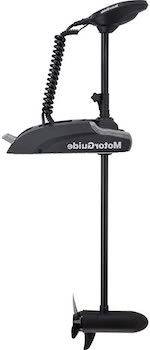

Our verdict: The MotorGuide Xi3 is the best spot lock trolling motor for kayak
If you’re specifically looking for a model that you can use on a kayak, then MotorGuide has the best option for you, with the Xi3 with a 36” shaft.
They created this version of the Xi3 specifically for kayak anglers, to allow for the shallow draught and low deck height of kayaks.
But be aware that the Xi3 for kayak comes in two different versions, one with GPS, and one without (the price difference being about $460).
However, if you get the this spot lock trolling motor without GPS, you can still retrofit it with GPS functionality afterwards, by using the Pinpoint GPS kit that MotorGuide sells separately.
After extensively testing it, we found that with 55 lb thrust the MotorGuide Xi3 has plenty of power for a kayak, and can hold a GPS position accurately even in relatively strong wind or current. This is especially nice when trying to stay on top of schools of fish.

Features
- Remote control
- 36” shaft length
- Pinpoint GPS
How does spot lock work on a trolling motor?
Spot lock uses GPS signaling to control the autopilot of a trolling motor to maintain boat position in a radius of 3 to 6 feet from a specific GPS position.
The algorithm compares the current set of GPS coordinates of the actual location with the desired location, and if there is a difference between them, it activates the trolling motor to take it back to the original location.
What trolling motors have spot lock?
Below is a list of the trolling motor brands and models that currently have spot lock functionality (as of early 2023):
Minn Kota
- Ultrex
- PowerDrive
- Riptide PowerDrive
- Ulterra
- Riptide Ulterra
- Terrova
- Riptide Terrova
Lowrance
- Ghost
Garmin
- Force
PowerGuide
- Xi3
- Xi5
- Tour Pro
Rhodan
- HD GPS Anchor Trolling Motor
Haswing
- Cayman GPS
Keep in mind that many of these spot lock trolling motors come in several different variations, some of which have a spot lock feature, and some don’t, so make sure to check this before you buy.
In addition, it’s possible to retrofit some Minn Kota and PowerGuide trolling motors with spot lock functionality after you purchase them, by using a kit specifically designed for this purpose.
But once again – this isn’t possible with every model, so you need to check it before buying.
What trolling motor has the best spot lock?
Until 2016, MotorGuide was the industry leader in terms of having the best spot lock trolling motors. But in late 2016 Minn Kota came out with the brand new Ultrex, which included a new generation of i-Pilot, and this has much higher accuracy than before.
When Minn Kota tested their Ultrex side by side with that of MotorGuide in 2017, their reinvented i-Pilot was significantly more accurate than that of the competition, managing to keep a boat within 3 to 6 feet of its GPS position, while the MotorGuide drifted 10 to 16 feet away from its GPS position (see the video below).
However, since 2017 all major trolling motor manufacturers have greatly improved their spot lock quality, which has enabled them to catch up with Minn Kota’s i-Pilot.
In fact, when we tested the Ultrex, Ghost, and Force side by side earlier this year, we found that they all three spot lock trolling motors have similar accuracy, managing to keep a boat within 3 to 5 feet from the original GPS coordinates.
It’s important to keep in mind that when checking spot lock accuracy, it’s essential to set up and calibrate your whole setup correctly, and you also need to choose the right amount of thrust for your boat. If you make a mistake, or skip a step in this process, you can easily end up with lower accuracy.
How to choose the best spot-lock trolling motor
When deciding on which spot-lock trolling motor to buy, it’s important to consider the key features and specs that will affect how well it performs for your specific purposes.
I highly recommend diving into the details and figuring all of this out before your buying decision, since that will save you a lot of headache later on.
So here are the most important factors to consider before buying the best spot lock trolling motor:
Thrust
When buying a trolling motor, it’s essential to choose a model with the right amount of thrust for your boat. If you choose an underpowered motor, it won’t be able to keep the GPS position accurately in strong wind or current, and if you choose an overpowered motor, it will tend to overshoot the mark when it moves your boat back to a GPS position.
Also, make sure to use the fully loaded weight of your boat when calculating the amount of thrust you’ll need. If you’re not sure how much your boat weighs, you can look it up on the NADA directory.
As a rule of thumb, aim for a minimum of 2 pounds thrust for every 100 pounds of fully loaded boat weight, and if you’re expecting a lot of wind or current where you fish, factor in about 20 to 30% extra thrust.
Voltage
The voltage requirement of a trolling motor is closely linked to its thrust, with higher voltages required for higher thrust. For most spot lock trolling motors you’ll need to decide in advance what thrust and voltage rating you need, and won’t be able to change that afterwards.
The exceptions to this are the Lowrance Ghost and Garmin Force, which both come with a variable voltage motor that can be used either with a 24 volt or 36 volt battery system.
The really nice thing about the variable voltage motors is that they not only make you more flexible in terms of what battery you can use, but they also allow you to easily adjust the thrust of the motor by changing from a 24V to 36V battery, or vice versa.
Finally, also adjust voltage according to how long you usually spend on the water. If you like to fish from dusk till dawn, a 36V battery is the best choice, as it will outlast a 24V battery. In addition to this, you may also want to look into recharging devices that allow you to keep your motor running no matter what the voltage.
Shaft length
It’s essential to choose the right shaft length for your boat size. If it’s too short, the prop won’t be properly submerged (especially in choppy water), and if it’s too long, the prop will tend to churn up mud in shallow water.
Ideally, you should aim for the shaft to be at least 12 inches submerged in the water, and hence the total shaft length you need to choose is determined by your boat’s deck height above water (i.e. the distance between the top of the bow and the waterline).
Here are the recommended shaft lengths for different bow heights:
| Distance from bow to waterline | Recommended shaft length |
|---|---|
| 0" to 16" | 36" |
| 16" to 22" | 42" to 45" |
| 22" to 28" | 46" to 52" |
| 28" to 34" | 53" to 62" |
| 34" to 44" | 72" |
| 44" to 64" | 87" |
Keep in mind that most bass boats require a relatively short shaft length between 45 and 55 inches, while larger boats (especially ocean going vessels), require longer shaft lengths up to 87 inches. And if you want to use the trolling motor in a kayak, then 24 to 36 inches is best for you.
GPS navigation
Most trolling motors reviewed above offer additional GPS navigation functionalities that require networking with a mapping device. Some of the most useful ones include autopilot navigation to a specific waypoint, retracing a saved track, or following a lake contour line at a specific depth.
Since most of these autopilot functionalities require networking with an external mapping device, you need to keep that in mind when choosing the right model for your purposes.
For example, if you’ve already got your boat set up with Humminbird electronics, it makes sense to get a Minn Kota, since that is designed to integrate with Humminbird devices.
In a case like that, it may not make sense to get a Lowrance Ghost or Garmin Force, which are incompatible with Humminbird units. However, this doesn’t apply if you plan to use the trolling motor independently, without networking it with your other electronics.
A special case in this category is jog functionality, which is available on Minn Kota and PowerGuide models.
This feature allows you to move your boat 5 feet in any direction from your GPS coordinates, and this is extremely useful when you want to systematically cover a whole area while fishing.
And if you want to use the Minn Kota jog functionality specifically, you’ll need to choose a Minn Kota model with i-Pilot plus heading sensor, which is necessary for jog functionality.
Foot pedal
The foot pedal is more important than most people think before buying a trolling motor. It’s important that it enables you to effortlessly control your GPS navigation and other functionalities merely by tapping the pedal or one of its side buttons.
Some foot pedals have side buttons that are hard to reach because they are located below the pedal on the side of the recessed tray.
In my opinion, the best pedal comes with the Lowrance Ghost, since all of the buttons are on the top part of the pedal, and so really easy to reach with your foot.
Another great thing about the Ghost foot pedal is that it includes two programmable buttons that you can use for any of your favorite features.
For example, you can use a programmable button to create waypoints without having to pause your fishing, which is really nice when you’re preparing for a bass tournament.
Or you could use it to control your shallow water anchors, again without having to stop fishing.
Remote control
In addition to a foot pedal, most trolling motors come with a remote control, which enables you to control your motor from anywhere on your boat.
While most anglers prefer having this option, some don’t really use the remote control.
In case you belong in this latter category, the Lowrance Ghost might be a good choice for you, since you can get it without the remote control, which helps to get the price down a little.
Transducer quality
Since many trolling motors now come with built-in transducers, you also need to consider the quality of the transducer you’re getting. The model in question is the Garmin Force, which comes with a high quality Garmin transducer with CHIRP, SideVu, and ClearVu sonar capabilities, and covering three frequencies (455/800 khz, as well as 1200 UHD).
Most other kinds of trolling motors come with much more basic transducers that only support 2D sonar, and come with only two frequencies.
However, in some cases you can choose a model with a more advanced transducer when you buy, or you can upgrade the transducer at a later time.
For example, the Ultrex can be purchased either with a basic universal transducer, or with a more advanced MEGA SI/Di transducer. And the Ghost has the option of replacing the standard hdi transducer with a 3-in-1 active imaging transducer.
Sonar compatibility
Sonar compatibility is extremely important to consider when buying a trolling motor, unless you don’t want to make use of the built-in transducer that comes with high end models nowadays.
This issue is especially important if you already have your boat full of one brand of sonar electronics, such as Lowrance, Garmin, or Humminbird.
In that case it’s often a good idea to choose a trolling motor that is compatible with your existing setup.
The main exception to this is the MotorGuide Xi5, which is compatible with any sonar brand.
Networking ability
As already mentioned, most trolling motors reviewed above are designed to be networked with other boat electronics, but usually they are only compatible with devices produced by the same company, which you need to keep in mind when choosing one.
Also, if you do get a brand that is compatible with your existing boat electronics, you still need to check the details of what it takes to network them with each other.
The Garmin Force is the easiest in this regard, since it supports wireless connection via Bluetooth, which makes networking the Force with existing Garmin electronics incredibly easy.
Minn Kota, on the other hand, is more complicated when it comes to networking. If you want to network the Ultrex with a Humminbird fish finder, you need to have i-Pilot Link, while the regular i-Pilot doesn’t work for this.
You also need to use an ethernet cable plus adapter to network them, since Humminbird uses different ethernet connections on their various devices.
Also, if you want to network more than one Humminbird unit with your motor, you’ll need an ethernet switch with multiple ports, plus additional cable and adapter.
Ease of getting replacement parts
When buying a high quality motor, you can expect it to have a long lifetime, and because of this it’s always a good idea to check how easy it is to replace or upgrade parts and accessories of your motor.
The model that really shines in this category is the Garmin Force, since it’s very easy to replace most of the parts yourself in case they get damaged, or if you want to upgrade them. For example, you can easily get a weedless prop, new handling cable, replacement skeg, etc..
Bow mount vs transom mount
While trolling motors can be mounted on either the bow or the transom, in the case of spot lock trolling motors you’ll probably want to choose a bow mount model.
The reason for this is that when holding a specific GPS position, a bow mount model tends to point your bow into the wind, which is usually more convenient for fishing. If mounted on the transom, however, it would tend to point your stern into the wind, which is much less convenient for fishing.
Conclusion
This wraps up our review on the best gps anchor lock trolling motor.
Ott Defoe attributed his victory in 2016 at La Crosseto to the fact that the GPS anchor lock of his Ultrex allowed him to fish at a fishing spot close to a spillway without having to pay attention to boat control.
This illustrates the unique ability of a GPS anchor can hold your boat in position accurately, while you’re free to focus on other things.
Hopefully you’ve found the right trolling motor for your purposes, which will help you to put lots of fish in the boat.
Gear and methods used for testing the best spot lock trolling motors
For consistent testing results, we ran all of the trolling motors described above on the bow of a Ranger Z520R bass boat. We tested each model for its ability to keep a spot lock in 15 to 20 mph wind, as well as its ease of deployment and general ease of use. We also tested each model in heavy grass to make sure it can perform well under rigorous conditions.








